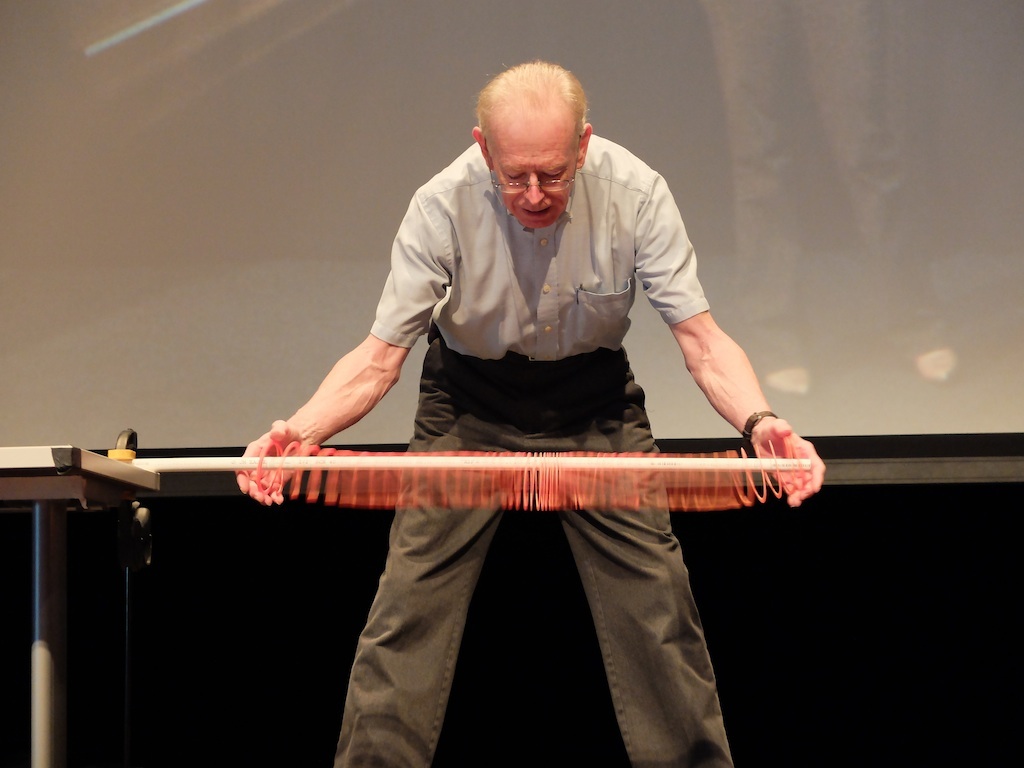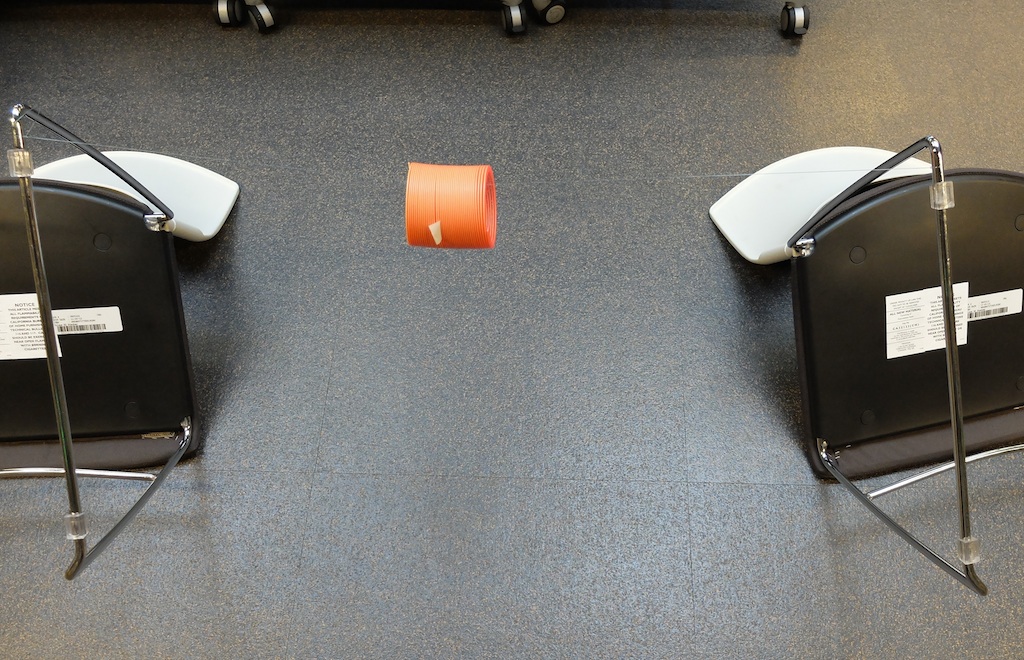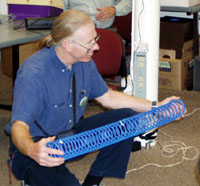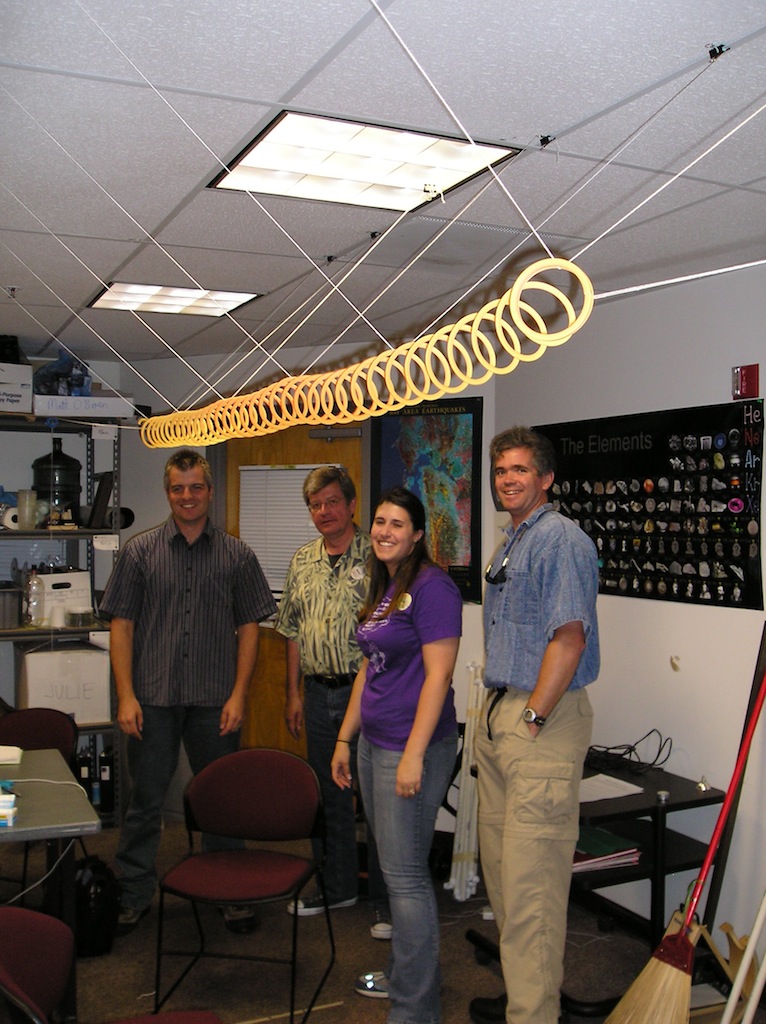Slinky in-hand
Making Waves

A slinky slodes on a PVC pipe clamped to a table. You can see the nodes!
Slinky in-hand
Making Waves

A slinky slodes on a PVC pipe clamped to a table. You can see the nodes!
Introduction
Hold a slinky between your hands, model transverse wave
resonances as well as longitudinal wave resonances. Learn about nodes
and antinodes of motion and compression.
Material
A slinky
about 3 meters of 20 pound test monofilament fishing line
2 chairs
Optional substitute for nylon line, a length of 1/2 inch PVC pipe
masking tape
Assembly
Tie the fishing line to a chair. After the first experiment
described below slide the slinky onto the fishing line then tie the
other end of the fishing line to another chair. Pull the chairs apart
until the line is taut.


A tightly stretched monofilament line supports a slinky.
Compressional waves are easily seen.
Optional,Thread the slinky onto a length of 1/2 inch PVC pipe. Place the pipe between two tables or clamp one end to a table.
To Do and Notice
Hold the slinky between your hands. The slinky will be horizontal
and sag.
Move both of your hands up-and down together. Find the lowest
frequency which produces the largest motion of the slinky for the
smallest motion of your hands. (About one cycle per second.) One
large hump, half-a-wave should appear moving up and down on the
slinky.
Count the rhythm every time the middle of the slinky hits bottom,
1,2,3,4,1,2,3,4,...

Notice that the center of the slinky moves up and down the most and
your hands the least.
Move your hands in opposite directions, that is, move the right hand
up when the left hand moves down and vice-versa. Move them in the
same rhythm as above. Notice that your hands move a large distance
whole the center of the slinky hardly moves at all. If you have
trouble, try this on a tabletop.

Count the rhythm every time your right hand hits bottom,
1,2,3,4,1,2,3,4,...
What’s Going On?
When you move your hands together you make a half-a-wave on the
slinky the middle of the slinky is an antinode, a point of maximum
motion while the handheld ends are nearly nodes, points of no
motion.
When you move your hands opposite, a half-a-wave also fits on the
slinky. However, this half wave has one node in the center and two
antinodes near the handheld ends.
The timing on both of these is the same, that is, the period is the
same. They both are resonances in which one-half-wave fits onto the
slinky.
Both of these patterns of motion have the fundamental frequency of
oscillation, the lowest frequency of motion for a slinky held at both
ends. It is close to 1 hertz.
Etc.
For the transverse motion of the slinky, at places where the motion
of the slinky passes through zero, a node of motion, the slope of the
slinky changes the most, an antinode of slope. So at the same places
where there are nodes of motion, there are antinodes of slope.
Longitudinal Waves
To Do and Notice
Thread the slinky onto the monofilament line as described under
assembly.
Grab the ends of the slinky in your hands.
Stretch the slinky to between 1 and 2 meters long.
Move your hands together and then apart, just as if you were
clapping. Notice the motion of the slinky. Your hands move a lot
while the center of the slinky moves very little. The center is a
node.
You can attach a small flag of masking tape to the center of the
slinky to make it easier to see that the center is not moving.
![]()
Next notice the spacing between the slinks (turns) of the slinky.
When the slinks are jammed close together the slinky models high
pressures in a gas, where the atoms are closer together. When the
slinks are far apart , the slinky models low pressure in a gas.
Let’s call closely spaced slinks high pressure and widely spaced
slinks low pressure.
Notice that the pressure change is greatest at the center where the
slinks alternately bunch-up and spread apart, and where the side to
side motion of the flag is the least.
Count the rhythm of this motion: 1,2,3,4,1,2,3,4,...
Move both hands in the same direction, if the slinky stretches
right-left move both hands to the left then to the right. (One of our
teachers described this as the sound of one hand clapping twice.)
![]()
Notice the motion of the slinky which is called longitudinal motion.
Find the frequency of hand motion that produces the largest motion of
the center of the slinky for the smallest motion of your hands.
Count the rhythm of this motion: 1,2,3,4,1,2,3,4,...
Notice that the center of the slinky is an antinode, your hands are
nearly nodes. The flag marking the center whips back-and-forth.
Notice that in the center the slinky moves back and forth but the
spacing between the slinks near the center does not change. The
center is an antinode of motion but a node ( a place with no change)
of pressure.
At the nodes of motion near your hands however the slinks bunch
together and then spread apart: the pressure changes a lot. The
handheld ends are antinodes of pressure.
Notice also that when one hand is at high pressure the other is low.
The ends then swap. The high pressure hand becomes a low pressure and
vice-versa. In other words, the slinks bunch up near one hand while
they spread out at the other.
What’s Going On?
When your hands move together one-half-wave of longitudinal motion
fits on the slinky. This is the lowest frequency resonance of the
slinky held at both ends, it is called the fundamental frequency.
When your hands move opposite, one-half-wave of longitudinal motion
also fits on the slinky but this time the node is in the middle while
your hands are near antinodes.
A sound wave is a longitudinal wave. A sound wave can be viewed
either as a wave of motion of atoms or as a wave of pressure. In a
standing sound wave in a tube nodes of motion occur at the same place
as antinodes of pressure. When both of your hands move together and
apart as in a normal clap you are modeling sound waves in a tube
closed at both ends. There are motion nodes at the ends and pressure
antinodes. When you move both hands in the same direction, the
non-clap, you are modeling a tube open at both ends. It has motion
antinodes at the ends and pressure nodes.
To Do and Notice
Find a higher frequency resonance of the longitudinal wave in which
you move both hands in the same direction (anti-clap). You should
have to move your hands about twice as often as in the lowest
frequency resonance you created before.
![]()
Count the frequency: 1,2,3,4,1,2,3,4
Notice the motion of the slinky, there are two nodes each about 1/4
of the way from each end. Mark the nodes with flags of masking
tape.
One full wave fits on the slinky.
When there is a high pressure near one node there is low pressure
near the other. The high pressure and low pressure regions switch
positions each cycle.
Move your hands opposite each other (clap) and find the next higher
resonant frequency.
![]()
nodes | | |
There will be three nodes on the slinky, one in the center and the
other two 1/6 of the slinky from each end.
3/2 of a wave fits on the slinky.
Notice the pressure changes on the slinky, when one node is
experiencing high pressure the adjacent one experiences low
pressure.
With time, each node oscillates from high pressure to low and back
again.
What’s Going On?
High pressure and low pressure nodes alternate in time as well as
in space.
To create an odd number of nodes move your hands opposite each other,
clap hands.
To create an even number of nodes move your hands in the same
direction.
Etc.
In the Exploratorium sound column a tall cement tube closed at both
ends you can create a standing sound wave by playing an aluminum bar
tuned to be in resonance with the column. When you place your ear at
the floor, at a node of motion, the sound is loud, when you raise
your ear to an antinode of motion the sound just about
disappears.
This shows that your ear detects pressure changes. The floor is an
antinode of pressure change.
Teaching tip.
Store slinkies in a ziploc bag to keep them from mating.


You can also hang a slinky from two cords, called a "Bifilar suspension" to make it show longitudinal waves.
Return to Day
10
|
Scientific Explorations with Paul Doherty |
|
3 May 1999 updated 17 Sep 2015 |